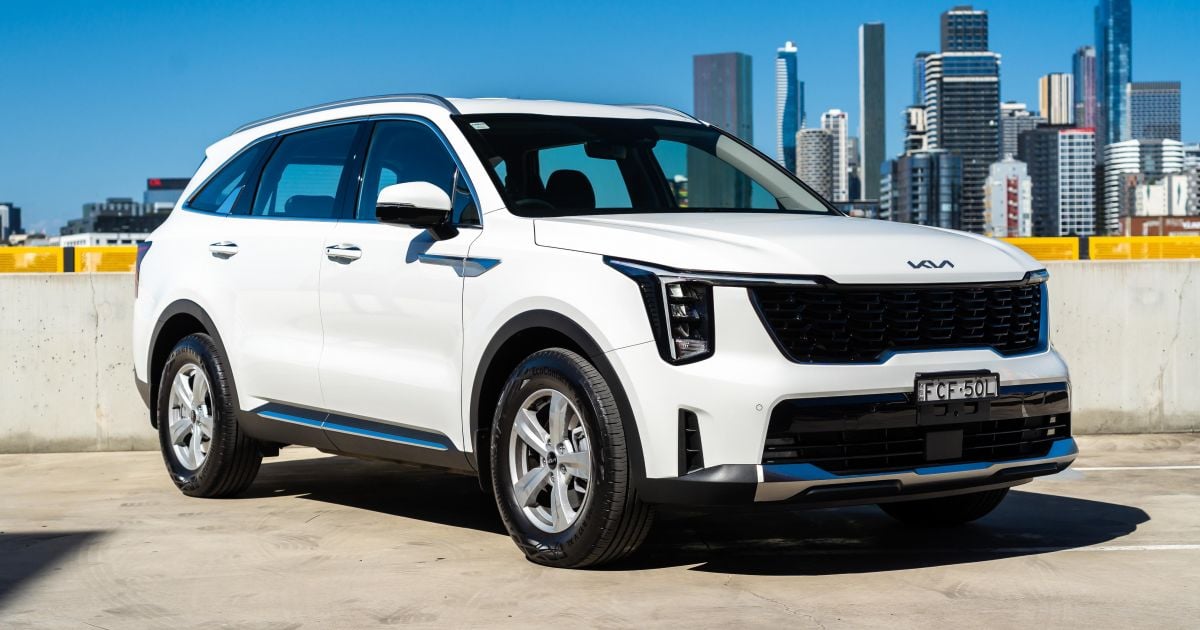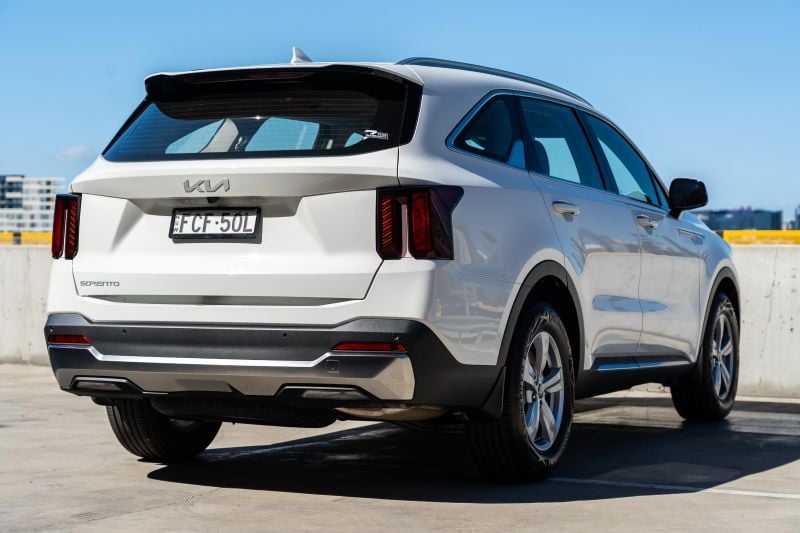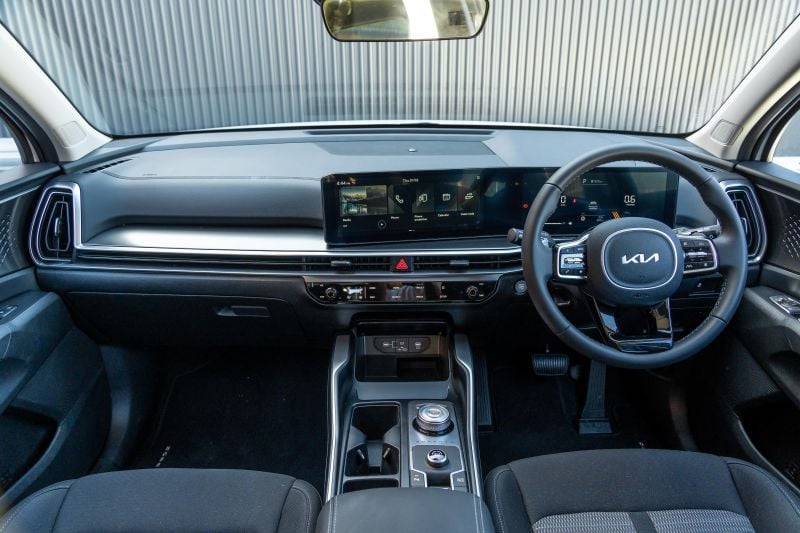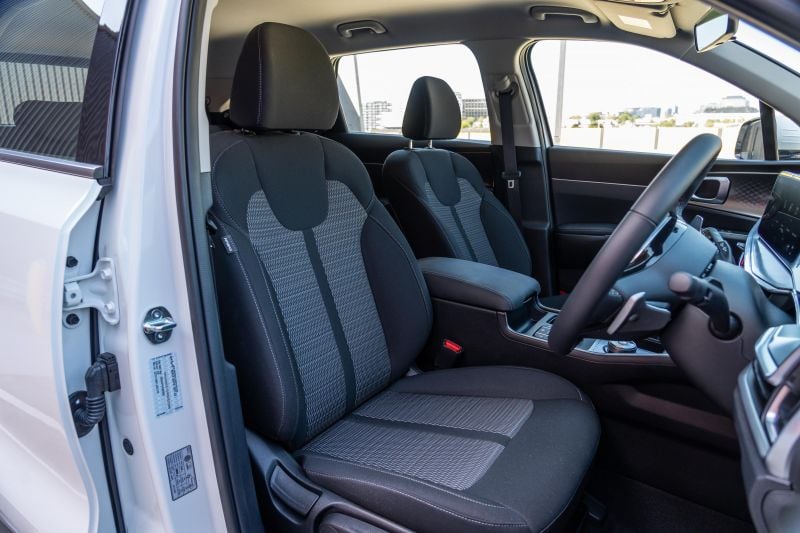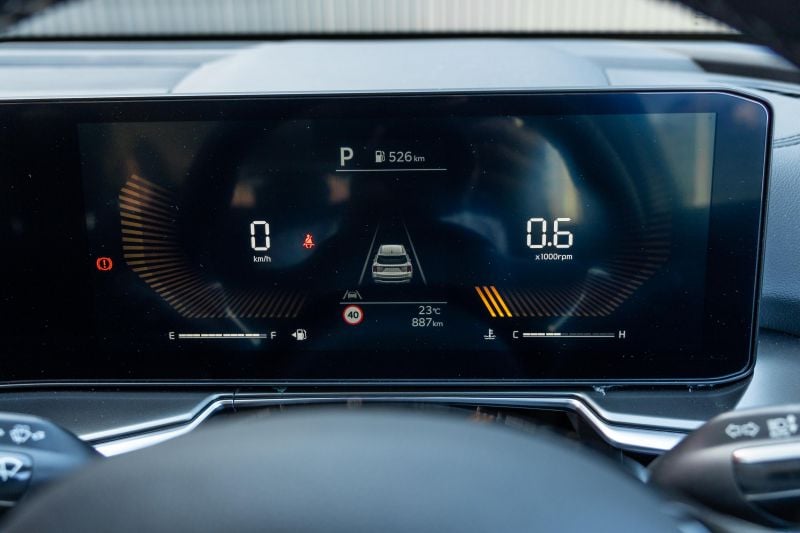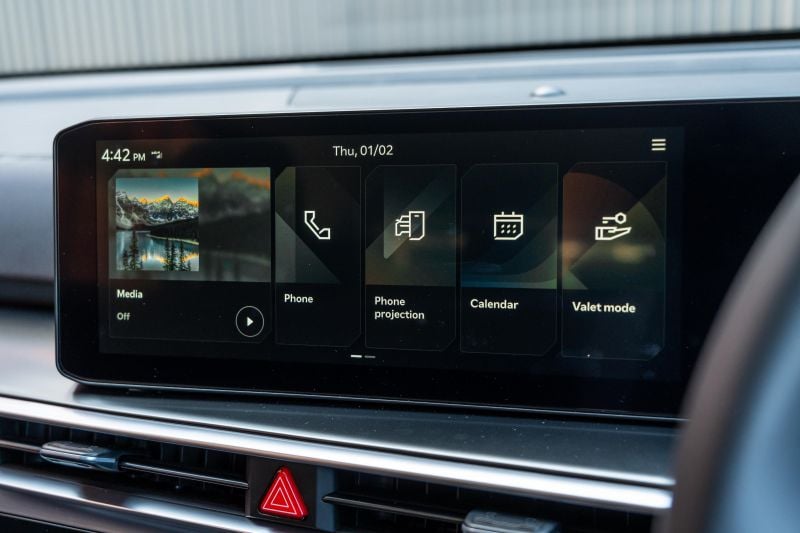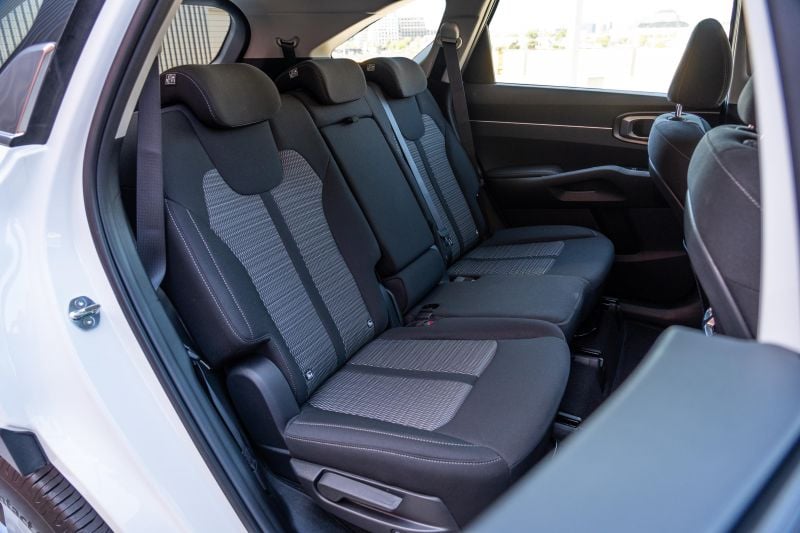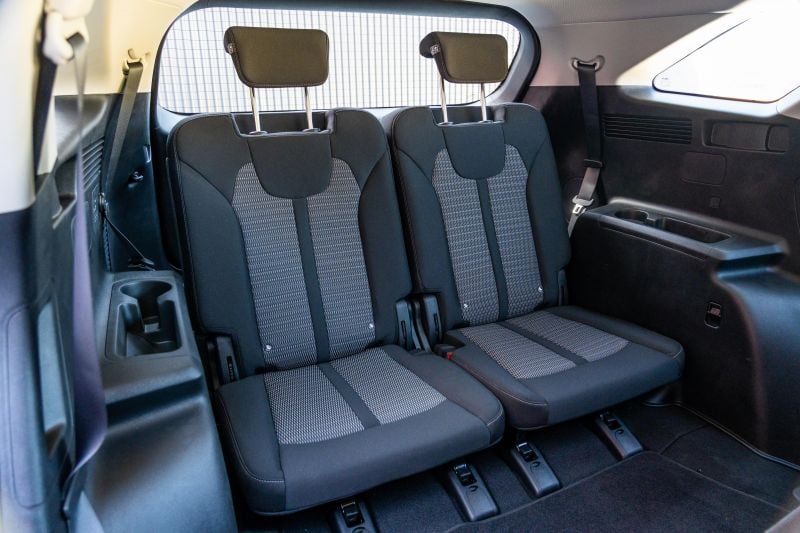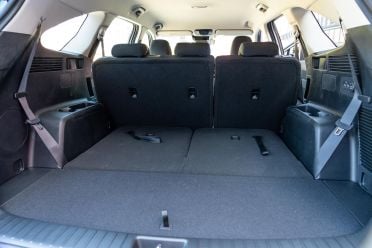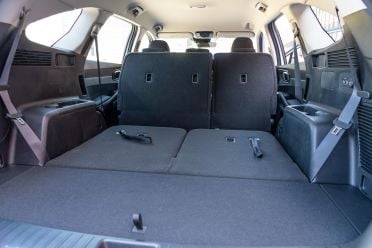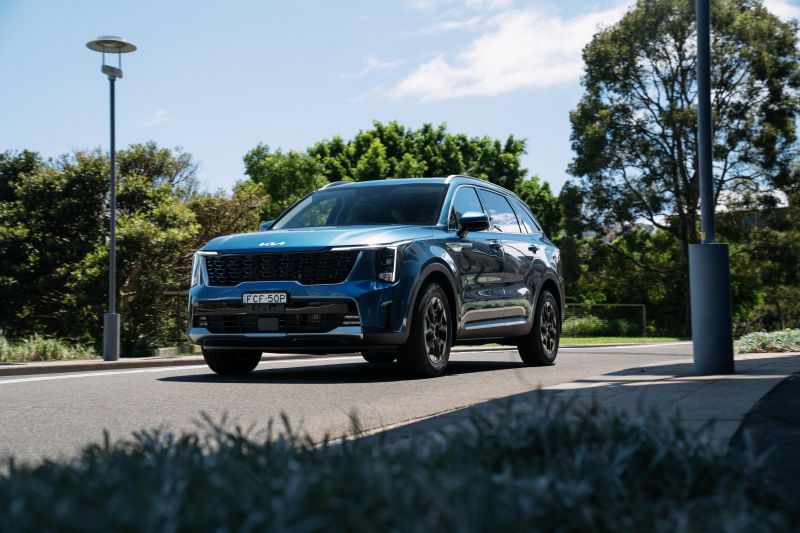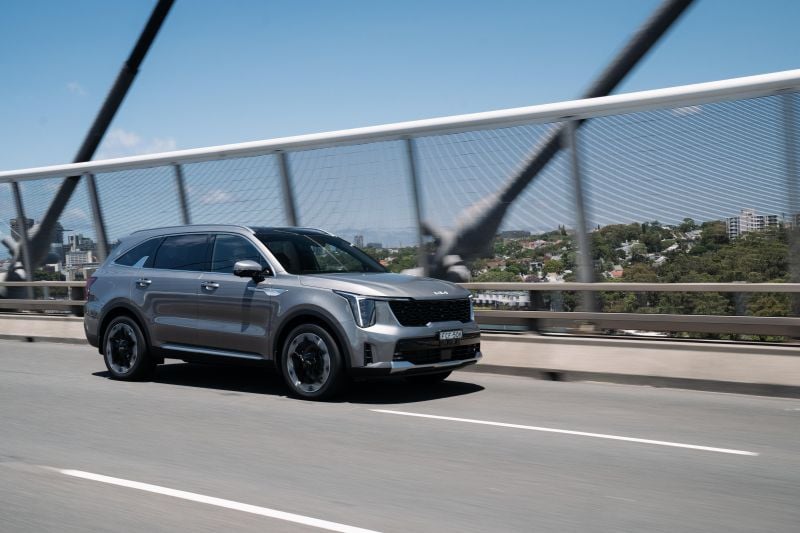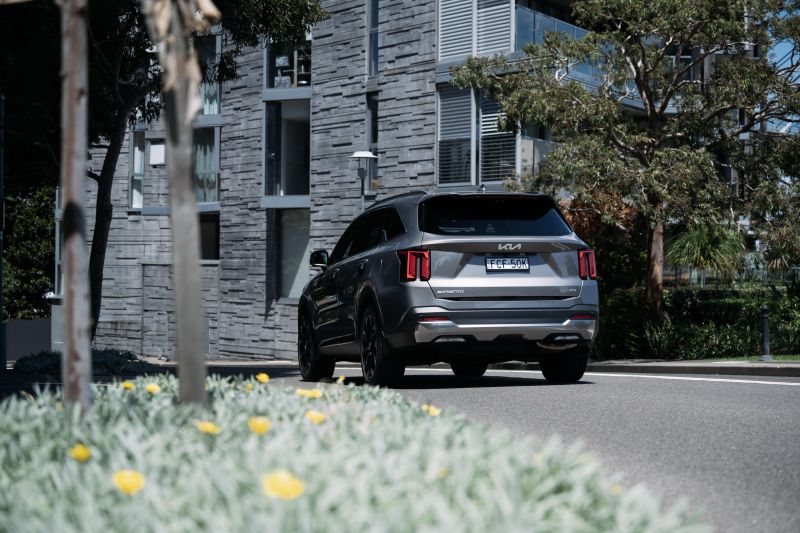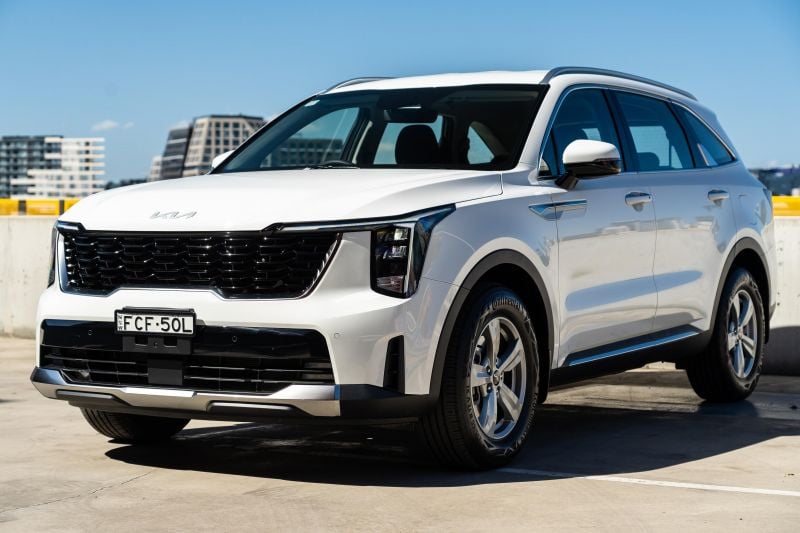Kia‘s largest internal combustion-engined (ICE) SUV on offer in Australia is the latest to undergo a facelift, which brings tweaks and new features all wrapped up in a package that commands a higher asking price.
The seven-seat Kia Sorento now adopts an EV9-like look which is increasingly common among updated models from the South Korean carmaker. It also gets a revised ride and handling tune, among other new infotainment and driver assistance technologies.
So far the majority of the hype has been surrounding the flagship GT-Line variants, though for this review we’re taking a look at the absolute base model – the 2024 Kia Sorento S V6 FWD.
Despite being a base model it still gets Kia’s new connected car Navigation Cockpit (ccNC) infotainment operating system with the larger 12.3-inch touchscreen, Kia Connect online telematics, a shift-by-wire gear selector, proximity entry with push-button start.
Is the entry-level Kia Sorento S all the car you really need? Read along to find out.
How does the Kia Sorento fare vs its competitors?
View a detailed breakdown of the Kia Sorento against similarly sized vehicles.

Kia
Sorento
How much does the Kia Sorento cost?
The base Kia Sorento S starts from $50,680 plus on-road costs for the V6 FWD version on test.
Kia Sorento pricing:
- 2024 Kia Sorento S V6 FWD: $50,680 (+$3030)
- 2024 Kia Sorento Sport V6 FWD: $53,300 (+$3030)
- 2024 Kia Sorento S Diesel AWD: $53,680 (+$3030)
- 2024 Kia Sorento Sport Diesel AWD: $56,300 (+$3030)
- 2024 Kia Sorento Sport+ V6 FWD: $58,230 (+$3380)
- 2024 Kia Sorento Sport+ Diesel AWD: $61,230 (+$3380)
- 2024 Kia Sorento GT-Line V6 FWD: $65,590 (+$3520)
- 2024 Kia Sorento GT-Line Diesel AWD: $68,590 (+$3520)
Prices are before on-road costs
The following nationwide drive-away prices are also available:
- 2024 Kia Sorento S V6 FWD: $54,090 (+$3300)
- 2024 Kia Sorento Sport V6 FWD: $57,090 (+$3300)
- 2024 Kia Sorento S Diesel AWD: $57,090 (+$3300)
- 2024 Kia Sorento Sport Diesel: $60,090 (+$3300)
- 2024 Kia Sorento Sport+ V6 FWD: $61,990 (+$3600)
- 2024 Kia Sorento Sport+ Diesel AWD: $64,990 (+$3600)
- 2024 Kia Sorento GT-Line V6 FWD: $69,690 (+$3700)
- 2024 Kia Sorento GT-Line Diesel AWD: $72,690 (+$3700)
To see how the Kia Sorento compares with its rivals, use our comparison tool.
What is the Kia Sorento like on the inside?
Walking up to the Kia Sorento you’re presented with a striking new EV9-like LED lighting signature, even on the entry-level S variant as tested here. There’s also a light in the front door handles that illuminate at night.
Hopping in and out is really easy due in part to the raised ride height. You can see why this kind of seating position is so sought after as you get a ‘king of the road’ vibe behind the wheel.
The entry-level Sorento S receives black embossed cloth upholstery as standard which has an inoffensive design with grey elements in the middle.
Both front seats are manually adjustable which is to be expected on an entry-level vehicle, but despite this there’s still a wide range of adjustment to dial in your perfect seating position. The only thing that’s lacking is a bit more thigh support.
The front seats are so comfortable they feel like lounge chairs and the headrest is really squishy. You can tell this car is built for long trips on the highway.
Ahead of the driver is the same steering wheel as the pre-update model, which isn’t the end of the world as it’s still a fundamentally good unit. It’s leather wrapped and feels nice in the hand with plenty of tilt and reach adjustment.
All the buttons and switches on the steering wheel all make sense, though it took me a while to remember which side was for cruise control and audio controls. I mixed them up a couple of times before realising.
Behind the steering wheel is a new basic digital instrument cluster that replaces the analogue dials of the pre-update model. There’s still a 4.0-inch LCD central display but it has new graphics which makes it feel fresh.
Despite this the basic digital instrument cluster was really dull even when the brightness was turned up all the way. It was even worse when I had my polarised sunglasses on.
The two digital panels sandwiching the 4.0-inch LCD central display constantly show your current speed (in digital form) and revs, and there are certain elements that change colour depending on which drive mode you’re in.
As usual the 4.0-inch LCD central display has a range of different informative pages that you can cycle through. For the most part I stuck with the trip meter page that showed how far I had travelled since refuelling the car and what fuel economy I was getting.
Moving across there’s a new 12.3-inch touchscreen infotainment system that’s part of the same wraparound housing as the basic digital instrument cluster.
The new touchscreen runs Kia’s new connected car Navigation Cockpit (ccNC) operating system that first debuted in the EV9 electric SUV.
To put it bluntly, the touchscreen is fantastic. It’s easily within reach for the driver making swiping between menus and pages an effortless task.
Another cool addition is wireless Apple CarPlay and Android Auto across the entire Sorento range. It was technically offered in the entry-level S variant in pre-update form, but that was because it had a small 8.0-inch touchscreen exclusively with wireless smartphone mirroring.
For the updated Sorento S, as tested here, this means it now gains wired Apple CarPlay and Android Auto, like the rest of the range.
For the majority of my time with our tester I used wireless Apple CarPlay with my iPhone 15 Pro Max and the connection was rock solid. This surprised me a bit because I was so used to how patchy wireless smartphone mirroring connection was the previous 8.0-inch touchscreen.
Something to keep in mind is the Sorento S doesn’t have a wireless charger, so if you want to keep your phone battery topped up you’ll need to plug it into one of the two new USB-C ports up front. You need to step all the up to the flagship GT-Line variant to get one…
The Sorento S also doesn’t receive satellite navigation, which isn’t surprising given it’s the entry-level model. It’s not the end of the world because you can simply use Google Maps with smartphone mirroring instead.
What is surprising however is this car now receives Kia Connect online telematics which was previously reserved for variants that had satellite navigation. This means you get functions like emergency calling, vehicle tracking, remote functions, valet parking mode, plus more.
Underneath the touchscreen is a new toggle-able HVAC and media control panel that takes a little to get used to but eventually makes logical sense. After a while the panel did get a little fingerprint-y however, which didn’t look very nice.
Looking around the cabin the majority of the finishes within reach and eyesight don’t look or feel cheap. I didn’t expect this given this is an entry-level car. Reach down further and you’ll inevitably find harder plastics.
One of my favourite parts about the Sorento’s interior is the general lack of glossy piano black finishes. There is the odd lashing, but the majority of the high traffic areas have a matte grey plastic that in my books looks a million times better. It will also most likely look nicer for longer.
All Sorento variants now receive a shift-by-wire rotary dial for the gear selector which looks really cool and provides vibration feedback when you select reverse. This shifter was previously reserved for the flagship GT-Line.
As usual there’s plenty of storage up front for bottles, phones, and other odds and ends. The cupholders are generously sized, there are other cubbies scattered around, and the door bins are big enough.
Moving to the second row there’s a palatial amount of space on offer. At a leggy 182cm tall I fit easily behind my driving position and there’s plenty of head and shoulder room.
The second-row bench is split 60/40 and can slide and recline independently. This allows you to stretch out or allow more space for people in the third row.
The floor in the second row is pretty much flat for the entire width, meaning you won’t have to play footsies with the person sitting the middle seat. The cabin is also wide enough that three adults will easily fit across the second-row bench.
Amenities in the second row include centre console-mounted air vents, a 12V socket, as well as a fold-down armrest with cupholders. There are also the requisite top tether points on all three second-row seats, as well as ISOFIX anchorages on the outboard ones.
Hopping into the third row of the Sorento can be a bit challenging due to the higher ride height. It’s not as easy as it is in the Carnival people mover.
Once you eventually get into the third row you realise it’s definitely more of a kids-only space. Headroom for adults is compromised, though leg, shoulder and toe room are okay.
Disappointingly there aren’t any air vents for those in the third row, which might be a pain if you have kids that are getting hot all the way at the back of the car. You need to step up to the Sport to get third-row fan control and vents.
The only main amenities in the third row are a set of cupholders and a 12V socket. There aren’t any USB ports and the armrests are many of rock-solid plastic.
Interestingly there are top-tether points and ISOFIX anchorages for the two third-row seats, but something to keep in mind is there is no full airbag coverage for the third-row.
Moving around the back the Sorento S has a manually opening and closing tailgate which is to be expected given it’s an entry-level variant.
Like the pre-update model, the button to open the boot isn’t where you would typically first look. It’s right at the bottom of the tailgate.
Kia also knows you won’t initially know where the tailgate latch is as there’s a sticker on the rear bumper that says to be removed once the owner is shown where it is. The sticker was still present on our tester.
Once the boot is open you’ll be presented with a rather small boot with the third row of seats upright, though backpacks and a couple of shopping bags will fit fine. Kia quotes a boot capacity of 179 litres with the third row upright.
When you stow the third row of seats the boot capacity expands to 608 litres. Now that’s more like it. You can also trigger the second-row seats to fold from the boot which further expands boot capacity to 1996 litres.
Under the boot floor there’s storage for a cargo cover, as well as tools to help lower down the full-size spare wheel which is mounted under the car.
It’s fantastic to have a full-size spare wheel in this kind of vehicle as you don’t have to worry about travelling at a reduced speed when it’s fitted. This makes ideal for travelling in rural and regional areas away from tyre repair shops.
What’s under the bonnet?
| Model | Kia Sorento V6 |
|---|---|
| Engine | 3.5L naturally aspirated V6 petrol |
| Power | 200kW |
| Engine torque | 332Nm |
| Transmission | 8-speed auto |
| Driven wheels | Front-wheel drive |
| Weight | 1898kg (tare) |
| Fuel economy (claim) | 9.8L/100km |
| Fuel economy (observed) | 10.8L/100km (400km mixed driving) |
| Fuel tank size | 67 litres |
| Fuel requirement | 91 RON |
To see how the Kia Sorento compares with its rivals, use our comparison tool.
How does the Kia Sorento drive?
Starting up the Kia Sorento S is now made even simpler thanks to a push-button start system. There’s also remote engine start that can be activated from the proximity entry key.
When the atmo V6 petrol as fitted to this tester first fires up there a sweet note. It reminds me a lot of my parents’ 1998 Mitsubishi Magna which is still driven around on their farm.
The engine’s idle can be a little high at first, though once it warms up it dips down very low. I haven’t seen an engine, yet alone a petrol one, idle at 600rpm at operating temperature in a very long time.
Setting off in the Sorento S you’ll first notice the accelerator is quite touchy. I found I had to use the ‘Eco’ driving mode to get the car to calm down because it would frequently chirp the front tyres if left to its own devices.
From a standstill you’ll be winning a lot races from the traffic lights if you’re that way inclined. The way the V6’s power is delivered is very instantaneous and intuitively linear. It’s also quite a rev-happy engine.
The eight-speed torque-converter automatic’s gear changes are largely intuitive and slick, though it will occasionally hunt around for gears when more power is needed.
I know this is a feature many Australians typically switch off straight away when first hopping into a car, but the Sorento doesn’t feature engine idle stop-start at all. If you plan on driving this car mainly on the highway that’s fine, but if you frequent built-up urban areas with heavy traffic this makes the Sorento V6 very thirsty very quickly.
When I was driving to and from the office in peak-hour Melbourne traffic I frequently saw consumption ranging between 12-14L/100km. It’s worth noting I didn’t see anything under 10L/100km throughout my entire week-long loan.
The steering in the Sorento is on the lighter side, though you still get a fair bit of feedback through the steering wheel. This results in the SUV feeling quite chuck-able and smaller than it actually is.
Another element the lighter steering helps out with is parking manoeuvres, though it’s hard to disguise the length of this vehicle when parking.
As standard the Sorento S comes with front and rear parking sensors, as well as a reversing camera with surprisingly fantastic picture quality. If you want a surround-view camera you need to step all the way up to the GT-Line.
Around town every single urban bump is soaked up beautifully. Even the roughest of speed bumps are a breeze in the Sorento S.
Kia has revised the Sorento’s ride and handling tune, including new frequency selective dampers which are claimed to improve ride comfort and body control.
The great ride is also likely thanks in part to the car’s smaller 17-inch alloy wheels that are wrapped in tyres with plenty of sidewall.
Building up speed in Sorento with the atmo V6 is so easy, but you need to be careful with the accelerator otherwise you’ll be paying at the petrol pump.
If you throw a few people in the car, as well as their stuff, be prepared for the fuel efficiency figure to rise further and the limits of the petrol engine to emerge. For this particular use case I’d argue the torquier turbo-diesel with its all-wheel drive grip and a better fuel economy might be the better pick.
When you’re slowing down from higher speeds in the Sorento is when you notice how large and heavy it is. The car does a good job at disguising its heft for the most part, but you’ll be reminded every time you look at how much brake dust there is on the front wheels.
At higher speeds the Sorento does also start feel just a bit like a barge. It’s a little on the softer side, but pretty much every bump is soaked up nicely.
On the safety front, the adaptive cruise control works as it should and it intuitive. The system thankfully doesn’t immediately slam on the brakes when a car merges ahead of you into your lane.
The lane-keep assist system worked well for the most part, but occasionally it would sometimes get sound a chime and vibrate the steering wheel even when I was still within the lines. This was most noticeable when using an off-ramp on a freeway.
The lane-centring system when activated also makes small jittering adjustments to keep the car centred in the lane. I preferred to keep this system off for the most part and would only suggest using it on well-marked highways and freeways with gentle turns.
One of the most infuriating safety systems with the updated Sorento however is the new Intelligent Speed Limit Assist feature that has been rolling up to Kia models for a while now. This system plays a chime when you surpass the posted speed limit for a certain period.
In theory this system should be really helpful to ensure people don’t speed, but at times the car detects an incorrect speed sign and sounds the chime. This is most notable when travelling through school zones when they aren’t active.
The only way to turn off the Intelligent Speed Limit Assist system is by going into a menu in the touchscreen. Sure you can program a shortcut button on the steering wheel, but you still need to use the touchscreen regardless.
Frustratingly the Intelligent Speed Limit Assist system also defaults to on every time you turn the car on. This means if you don’t like it you’ll need to dive into the touchscreen to switch it off every time you drive.
Lastly, although the Sorento S comes with LED headlights, they are of the reflector variety which are a little dull. If you want projector-style LED headlights you need to step all the way up to the flagship GT-Line variant.
What do you get?
Sorento S highlights:
- 7 seats
- 17-inch alloy wheels
- Full-size spare wheel
- Automatic reflector-type LED headlights
- Automatic high-beam
- LED daytime running
- LED front fog lights
- LED rear fog light
- Rain-sensing wipers
- Power-folding side mirrors
- Acoustic windscreen
- Basic digital instrument cluster incl. 4.0-inch LCD display
- 12.3-inch touchscreen infotainment system
- Wired, wireless Apple CarPlay, Android Auto
- DAB+ digital radio
- 7-speaker sound system
- Manual air-conditioning
- Second-row vents
- Proximity entry and push-button start
- Remote engine start
- Shift-by-wire gear selector
- Leatherette-wrapped steering wheel
- Paddle shifters
- Embossed cloth seats
- 6-way manual driver’s seat adjustment
Is the Kia Sorento safe?
The Kia Sorento was awarded a five-star ANCAP safety rating based on testing conducted in 2020.
It received an adult occupant protection score of 82 per cent, child occupant protection score of 85 per cent, vulnerable road user protection score of 63 per cent, and safety assist score of 89 per cent.
Standard safety equipment includes:
- Autonomous emergency braking (AEB)
- Car detection
- Pedestrian detection
- Cyclist detection
- Junction assist
- Blind-spot assist
- Rear cross-traffic assist
- Lane-keep assist
- Lane Following Assist
- Adaptive cruise control
- Intelligent Speed Limit Assist
- Driver attention alert
- Safe Exit Warning
- Reversing camera
- Front, rear parking sensors
- Tyre pressure monitoring
All models now also receive Kia Connect online services, which include:
- eCall
- Remote lock
- Remote climate control
- Vehicle tracking
- Vehicle status monitoring
- Voice assistant
- Destination send to vehicle
- Real-time traffic updates
- Valet parking mode
How much does the Kia Sorento cost to run?
The 2024 Kia Sorento is covered by a seven-year, unlimited-kilometre warranty like the rest of the Kia line-up.
Logbook servicing is required every 12 months or 15,000km or, whichever comes first. The first seven services are capped at the following:
| Service | Cost |
|---|---|
| 12 months/15,000km | $369 |
| 24 months/30,000km | $581 |
| 36 months/45,000km | $445 |
| 48 months/60,000km | $764 |
| 60 months/75,000km | $416 |
| 72 months/90,000km | $731 |
| 84 months/105,000km | $441 |
CarExpert’s Take on the Kia Sorento
Although the Kia Sorento S does look like a base model from the outside due to its smaller 17-inch alloy wheels, you’d be hard pressed to tell from the inside.
The new connected car Navigation Cockpit (ccNC) infotainment operating system with the larger 12.3-inch touchscreen is fantastic and it’s nice to finally have reliable and consistent wireless Apple CarPlay connectivity.
If you’re after certain features however like third-row air vents, second- and third-row USB chargers, power tailgate or a surround-view camera, you’re forced to look further up the range.
Kia’s revised ride and handling tune has made the Sorento a more comfortable car overall. The entry-level S variant was already a good base to start with though given its tyres have chubby sidewalls.
Where this car is let down in particular is with its atmo V6 petrol engine. Sure it’s a sweet rev-happy unit, but given there’s no start-stop system this causes fuel efficiency to balloon out well beyond 10L/100km which is far too much for this kind of vehicle in 2024.
With this in mind, if you’re quite happy with sticking with the entry-level S variant I’d personally opt for the torquier turbo-diesel engine even though it is $3000 more expensive as it also gives you all-wheel drive reassurance. You won’t be disappointed.
Click the images for the full gallery
MORE: Buy a Kia Sorento
MORE: Everything Kia Sorento

